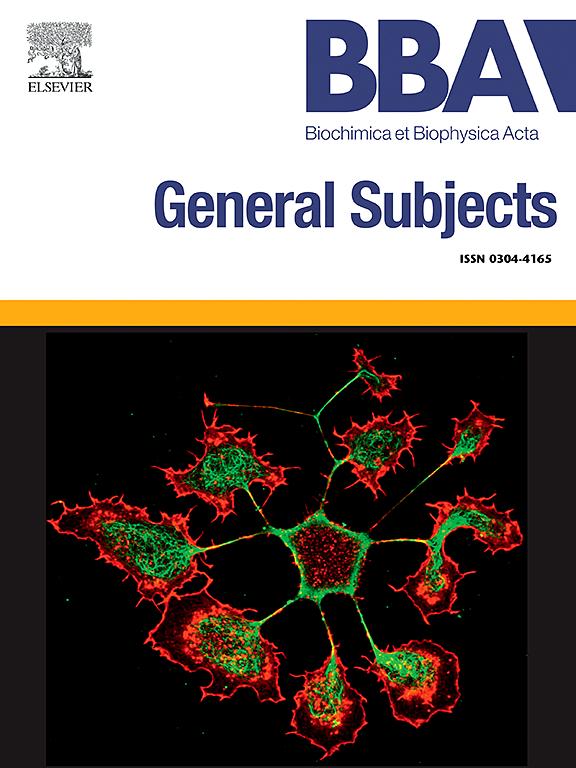The roles of intrinsically disordered proteins in neurodegeneration
IF 2.2
3区 生物学
Q3 BIOCHEMISTRY & MOLECULAR BIOLOGY
Biochimica et biophysica acta. General subjects
Pub Date : 2025-02-13
DOI:10.1016/j.bbagen.2025.130772
引用次数: 0
Abstract
Neurodegenerative diseases such as Amyotrophic Lateral Sclerosis, Alzheimer's disease, Parkinson's disease, and Huntington's disease share a common pathological hallmark: the accumulation of misfolded proteins, particularly involving intrinsically disordered proteins (IDPs) like TDP-43, FUS, Tau, α-synuclein, and Huntingtin. These proteins undergo pathological aggregation, forming toxic inclusions that disrupt cellular function. The dysregulation of proteostasis mechanisms, including the ubiquitin-proteasome system (UPS), ubiquitin-independent proteasome system (UIPS), autophagy, and molecular chaperones, exacerbates these proteinopathies by failing to clear misfolded proteins effectively. Emerging therapeutic strategies aim to restore proteostasis through proteasome activators, autophagy enhancers, and chaperone-based interventions to prevent the toxic accumulation of IDPs. Additionally, understanding liquid-liquid phase separation (LLPS) and its role in stress granule dynamics offers novel insights into how aberrant phase transitions contribute to neurodegeneration. By targeting the molecular pathways involved in IDP aggregation and proteostasis regulation, and better understanding the specificity of each component, research in this area will pave the way for innovative therapeutic approaches to combat these neurodegenerative diseases. This review discusses the molecular mechanisms underpinning IDP pathology, highlights recent advancements in drug discovery, and explores the potential of targeting proteostasis machinery to develop effective therapies.
内在紊乱的蛋白质在神经变性中的作用。
神经退行性疾病,如肌萎缩性侧索硬化症、阿尔茨海默病、帕金森病和亨廷顿病都有一个共同的病理特征:错误折叠蛋白的积累,特别是涉及内在无序蛋白(IDPs),如TDP-43、FUS、Tau、α-突触核蛋白和亨廷顿蛋白。这些蛋白发生病理聚集,形成破坏细胞功能的有毒内含物。包括泛素-蛋白酶体系统(UPS)、泛素非依赖性蛋白酶体系统(UIPS)、自噬和分子伴侣在内的蛋白质稳态机制的失调,通过无法有效清除错误折叠的蛋白质,加剧了这些蛋白质病变。新兴的治疗策略旨在通过蛋白酶体激活剂、自噬增强剂和基于伴侣的干预来恢复蛋白质稳态,以防止IDPs的毒性积累。此外,了解液-液相分离(LLPS)及其在应力颗粒动力学中的作用,为异常相变如何导致神经退行性变提供了新的见解。通过靶向参与IDP聚集和蛋白质平衡调节的分子途径,以及更好地了解每个成分的特异性,该领域的研究将为创新治疗方法铺平道路,以对抗这些神经退行性疾病。本文讨论了IDP病理基础的分子机制,强调了药物发现的最新进展,并探讨了靶向蛋白质平衡机制开发有效治疗的潜力。
本文章由计算机程序翻译,如有差异,请以英文原文为准。
求助全文
约1分钟内获得全文
求助全文
来源期刊

Biochimica et biophysica acta. General subjects
生物-生化与分子生物学
CiteScore
6.40
自引率
0.00%
发文量
139
审稿时长
30 days
期刊介绍:
BBA General Subjects accepts for submission either original, hypothesis-driven studies or reviews covering subjects in biochemistry and biophysics that are considered to have general interest for a wide audience. Manuscripts with interdisciplinary approaches are especially encouraged.
 求助内容:
求助内容: 应助结果提醒方式:
应助结果提醒方式:


